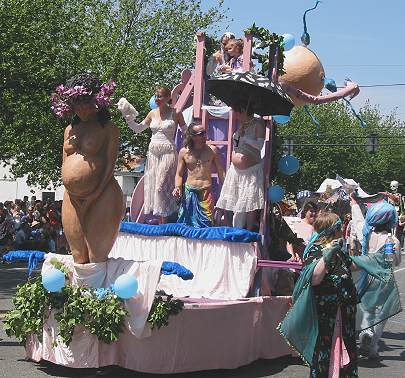…last Sunday, the 29th one in this town. This year’s was perhaps bigger and more outrageous than ever.
Certainly there’s a greater need for out-loud outness this year. Our appointed leaders have decreed that this nation must fight back against sectarian, authoritarian, intolerant murderers by becoming more sectarian, authoritarian, intolerant and murderous. Such a scenario would most certainly be unfriendly toward queer civil rights.
So out came the Outs, as forcefully outrageous as ever. There were the bar- and beer-company floats, the community-organization floats, the religious-tolerance marchers, the motorcycle lesbians, the drag-queen troupes, the performance artists, and the AIDS-awareness leafleters.
(Comparatively under-represented this year: Topless women; local politicians of any attire. Apparently absent: The tiny Gay AA delegation, which had always been vastly overwhelmed by the beer floats.)
Dan Savage used to say the Pride Parade ought to be at night, downtown, and more confrontative in nature.
But the Broadway, high-noon format is a more Seattle-style approach. It’s funky and quirky, silly and celebratory.
And yes, it’s assimilationist. It fetes the arrival of lesbians and gays as accepted and unthreatening members of the local affluent class.
Of course, it helps that the corporate-Democrat local power structure luuvvvs gay culture. More precisely, it loves a certain vision of gay culture that’s all about show tunes and interior decoration and anti-Republican political organizing, and only very understatedly about oral-genital contacts with persons of the same sex. The Pride Parade gays are sex-positive, but they know when to keep the curtains drawn.
LAST YEAR AT THIS TIME, we openly wondered in this space why nongays couldn’t have a sex-positive summer exhibition. SIlly us–we’d forgotten about the Fremont Solstice Parade, held (last year as this) just one week prior to the gay event.
Just as the gay parade isn’t exclusively gay, the Fremont parade is by no means exclusively straight. But it’s got a het aesthetic to it. Where the gay parade is about loudly and in many cases campily proclaiming one’s queerness (and one’s legal/social right to make such proclamations), the Fremont parade is about comfortably living in one’s oddness and intermixing with everyone else’s oddnesses.
The nude bicyclists, an unofficial part of the parade for over half a decade now, are only the most obvious incarnation of this aesthetic. Many, if not most, of the parade’s scheduled acts and icons involved zestful, vigorous depictions of masculine and feminine archetypes, both old (Pan, Pandora) and recent (loggers, businesswomen); sometimes in conflict with one another but all residing, however uneasily, in tghe same universe.
Heterosexuality, of course, is more likely to generate children. Such persons were in clear attendance at the gay parade, but were everywhere at the Fremont parade. They received candy, made chalk drawings, shook the hands of costume characters, were the chief audience of several floats and performers, and were the partial subject of the parade’s most intriguing float.
Based on the related topics of pregnancy and its avoidance, the float featured a traditional fertility goddess at the front, egg-and-sperm representations on the back, real-life moms-to-be, and real-life moms with their progeny (not visible in the shot). All around the float walked costume characters dressed up as assorted contraceptive devices. Possible implied meanings: Trying to get pregnant and trying not to get pregnant are merely different aspects of the whole shtick of being what gays used to call “a breeder;” sexual attraction, and the cycle of life of which it is a key part, are both to be joyously celebrated.
 |
Self-help mogul Stephen Covey once wrote something about a “maturity continuum,” in which dependent children become independent adults, who eventually recognize their interdependence with each other. I’ll add that true heterosexuality is also about that, at least ideally–not about greedy conquests or individual preenings, but about connecting to another person (and indirectly, spiritually, to the whole of the species).
It’s also about getting over the fear, reaching beyond your own head, negotiating the stickier parts (literally and figuratively) of such interconnections. That’s certainly a skill the world needs to get better at, on all levels.
I’ve written previously that we live in “a MISC world,” filled with untold numbers of cultures, subcultures, sub-subcultures, ethinicities, religions, and sex/love proclivities. Real heterosexuality is a key, perhaps the key, toward making such a world work–learning not only to tolerate but to share enduring love with someone fundamentally different from yourself.
What some socio-philosophers call “pansexuality,” I call ultimate heterosexuality–one big motley melange of women and men, and also of gays, lesbians, bis, trannies, SM-ers, swingers, monogamists, celibates, exhibitionists, voyeurs/voyeuses, femmes, butches, fairies, studs, princesses, and folks who don’t know what the heck they are; all finding consensual mind-bending togetherness with whomever, all ssupporting one another in stumbling through this miasma known as human existence.